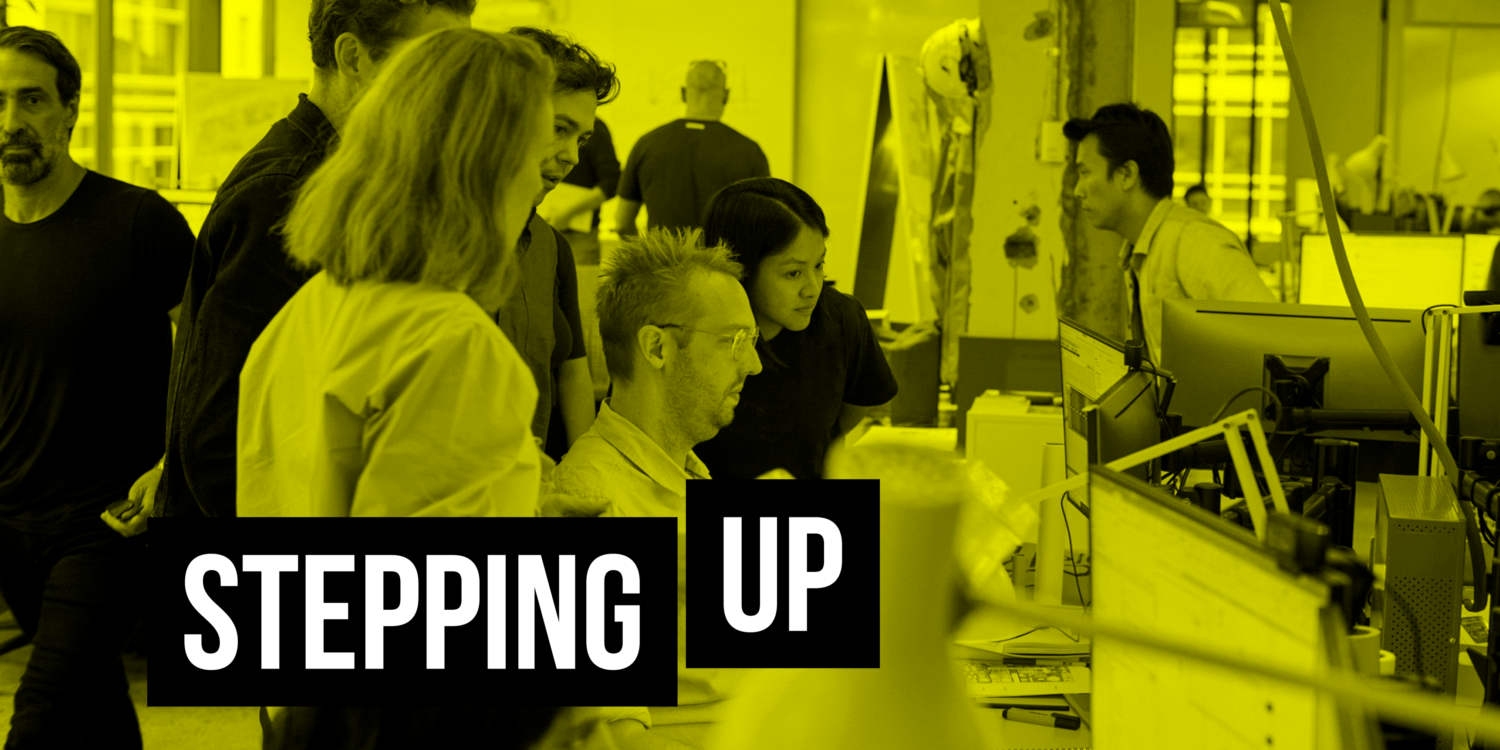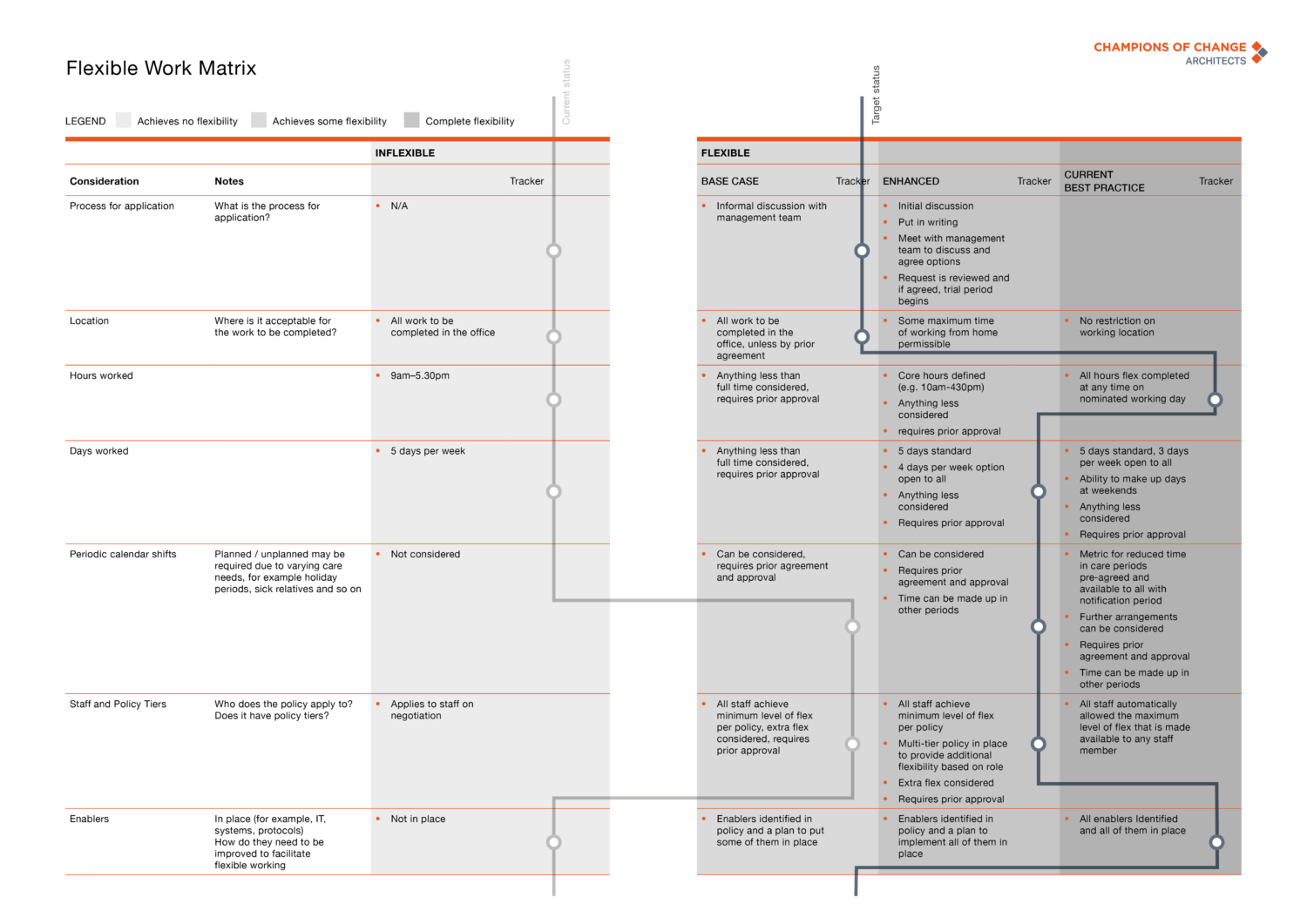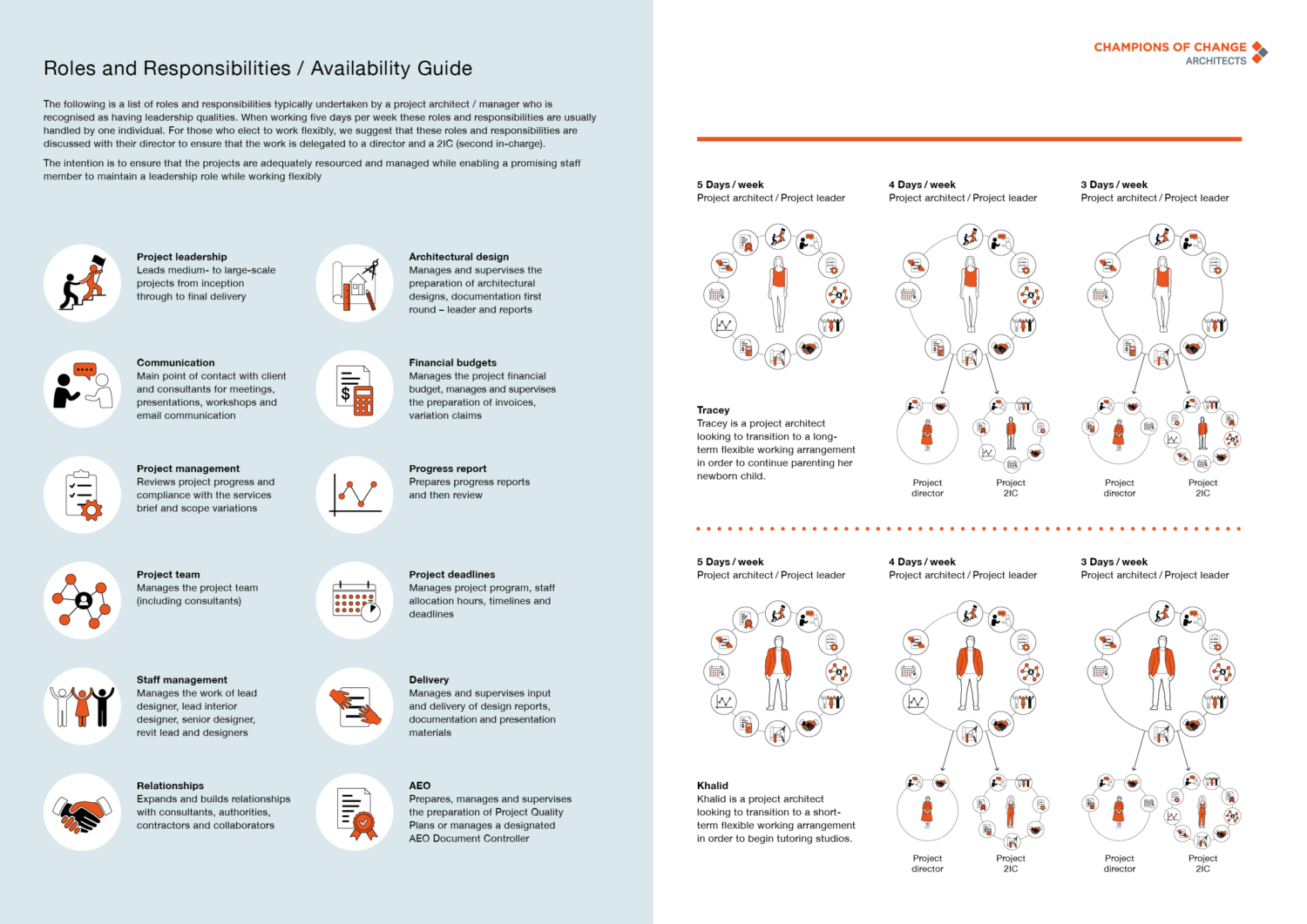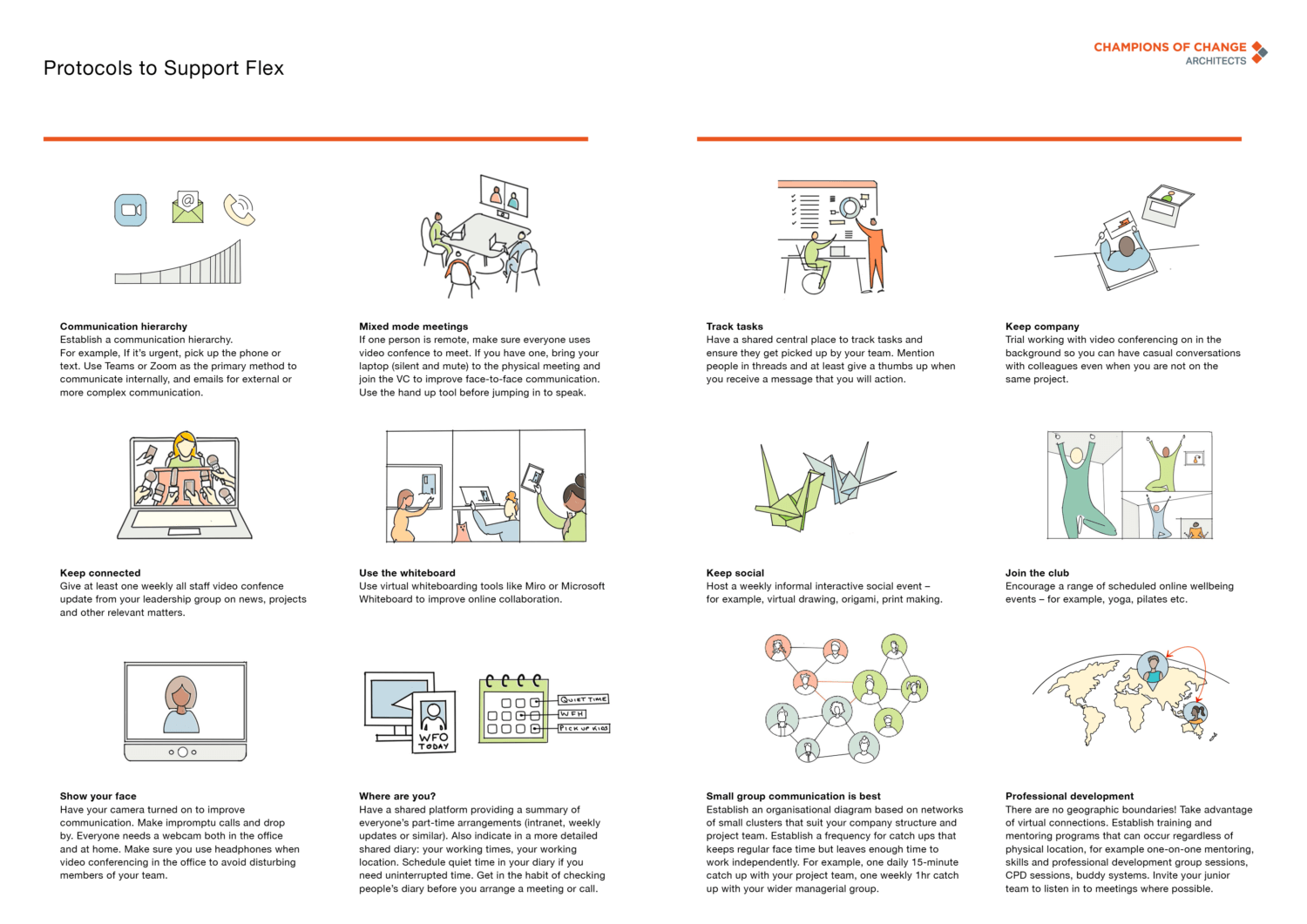An open and transparent flexible work policy is critical to fostering an effective, collaborative and healthy workplace, where people feel supported if they choose to work flexibly and where meaningful and rewarding career opportunities are available to all. This article includes practical advice on developing and implementing a flex policy based on the experience of the Champions of Change Architecture Group.

An effective policy provides clarity for those seeking to work flexibly, while promoting a collaborative culture where teamwork and engagement are central to success. The policy must reflect the values, cultures and aspirations of the practice, and those who lead it. It should be an active document embedded within the life of the practice. Easily accessible to all, it should be reviewed on a regular basis. Leaders must wholeheartedly stand behind a flex policy if it is to succeed in its implementation.
Flexible working is first and foremost a matter of culture. The policy supports this culture. To make flexibility work, a practice needs a strong group of trusted professionals who understand flexibility as a tool and an important way of working. The ability of a practice to take advantage of flexibility will always depend on a relationship of trust and reputation, of reliability and clear communication within the office.
This article offers an approach to developing and implementing a flex policy, based in the experiences of the Champions of Change Architecture practices. It is organised into four sections:
Developing a Flex Policy
There are a number of steps to developing a policy – from understanding the content, to articulating ambitions to reviewing, testing and refining.
1
Review your practice profile, research best practice & develop the business case.
Identify where your practice is currently, and research legal obligations and best practice.
Research industry standards and best practice
There is a substantial body of material available to support those developing flexible work policies, within architecture and in Australian workplaces more broadly. Other articles in this set are an excellent place to start, as is the Parlour Guide to Flexibility. What is Flexibility and Why does it Matter? provides a broad overview, the Case Studies document experiences of other practices, while the Resources provides useful link to advice and research elsewhere.
Understand your legal obligations as an employer
The Fair Work Act 2009 provides employees with the right to request flexible working conditions, provided they have been employed for 12 months and they fall into one of a number of categories, most of which relate to caring responsibilities, health, ability, age and domestic violence. The Fair Work Ombudsman notes that best practice employers should go beyond their minimum legal obligations and let all employees request flexible work arrangements, giving their employees flexibility where possible to help them balance their work and personal lives.
Collate data to help understand your practice
A good starting point in the policy design process is to understand the current position of the practice – what models of flexible work are currently in use? What are your team’s general expectations around Flex?
This is helpful to understand the lie of the land, even if all expectations aren’t catered for within the final policy. Indeed, expectation management (at all levels) is also an important part of the design and implementation process.
Depending on the size of your practice, this phase could occur through individual conversations, group consultations (such as a Listening and Learning session), a practice-wide survey, or all of the above. The advantage of a survey is that it will allow you to track patterns of flexible working overtime.
Metrics examined can include:
2
Understand where your practice is at & what needs to change
The next step is to articulate the practice’s aims and ambitions for flexible work, identify what can be improved and where the practice wants to be, and the timeframes for this to occur. The Flexible Work Matrix provides a useful tool for assessment.
3
Develop & implement the policy
It is important to develop and implement a policy and procedure that fits the language and culture of the practice.
4
Testing & review
The introduction of a flex policy is not a set and forget situation. Successful implementation requires continuous monitoring and feedback from employees, managers and employers.
5
Ongoing measurement & refinement
Regular staff surveys and analysis of metrics are key to the ongoing success and relevance of your flex policy.
Flexible Work Matrix
The Flexible Work Matrix is a useful tool for assessing where your practice is, and identifying where it wants to be. It provides a detailed outline of flex considerations and options, and is useful as both a planning tool and a framework for discussion.
It documents four phases – from an inflexible workplace, to three stages of flexibility (base case, enhanced and best practice). Each practice can track where they currently are against each consideration and where they want to be.
The image below provides an example of how a practice can plot where it is and where it wants to be through a range of variables.

Components of a Flex Policy
A Flexible Working Policy includes a range of components. There is no one-size fits all, and each policy should reflect the values and culture of the practice. This section offers an outline of key components and examples that can be used as the basis for practices to develop their own policy.
Principles
Establishing the principles that underpin the policy helps to guide its development and integrate it into the culture of the practice. Principles provide an important framework for assessing the detail of a policy and its impact and implementation.
Sample principles
The example offered below was developed by the Champions of Change Flexibility Action Group. Each practice should tailor the principles to suit the particulars of their practice:
- Flexibility is about maximising productivity and value; offering flexibility ensures that the practice can hire and retain the best and brightest staff.
- The foundation of successful flexible working is trust and communication. No arrangement can work without this.
- There are different ways to work flexibly – some flexibility is structural (formal flex) and some is incidental (Informal flex).
- Flexibility is a two–way street – sometimes you get it, and sometimes you give it.
Processes, protocols & procedures
A policy should outline the procedures for developing and implementing formal flex agreements under the flex policy. These flexible working arrangements are individually negotiated and approved on a case-by-case basis. It is also important to note that flexible work arrangements may not be appropriate for all roles.
Sample processes, protocols & procedures
The following are offered as an example of processes and procedures that may be adapted to suit:
Applying for flex
- Discuss with your HR/practice manager and director.
- Confirm your application in writing.Assessment will be undertaken by your HR/practice manager. Any amendments will be discussed and agreed with you.
- A formal approval will be provided to you in writing within 21 days of your application.
- The approval will form an amendment to your contract.
Location
- Confirm what % of work is to be undertaken in the studio.
- Confirm what % of work is to be taken outside of the studio.
- [Insert company name] has a minimum policy of % in time to be spent in the studio.
Remote working
- Complete the remote working checklist.
Flexible hours
- Core hours are defined between 9am and 5.30pm as per your employment contract.
- Anything outside this will be considered and requires prior approval.
Part-time work
- Anything less than five days per week will be considered and requires prior approval.
Periodic calendar shifts
- Planned shifts must be applied for in writing.
Job sharing
- [Insert your approach to this here]
Communications & management
- Roster of days made available to all staff
- Calendar sharing
- Daily email updates
Trial period
- Trial period of three months before formalising.
Review
- Review period is three months unless otherwise agreed
- Adjustments to the flexible arrangement may be required before formalising
- Annual review
Responsibilities
A flex policy should identify the responsibilities of the employer and employee in implementing the policy.
Sample responsibilities
The following are offered as an example that may be adapted to suit:
Employer responsibilities
- Encourage effective, open and transparent communication.
- Provide business software and reasonable remote IT telephone support that allow working outside of the studio.
- Provide team support system to ensure flexible work arrangements do not impact project deliverables.
- Provide clarity on time expectations for business and team structures.
- Encourage a culture of trust, supportive of flexible working.
- Discuss implications to change of contact (for example, leave and salary entitlements).
- Endeavour to schedule meetings, which suit flexible working arrangements.
Employee responsibilities
- Encourage effective, open and transparent communication.
- Carefully assess and analyse flexible working needs and communicate these clearly.
- Be prepared to offer flexibility in return to support others.
- Be aware of the impact your flexibility has on the time management of others.
- Be a positive example for flexible working to assist with cultural change.
- Be prepared to refine your flexible working arrangements to benefit all.
- Ensure access to electronic diaries for management and team members and complete the “out of office” form.
- Record your “out of office” time in your diary and provide a contact number.
- When working in a remote location, work in an environment that is distraction free and conducive to productive activity with [Insert company name] business remaining the primary focus.
- Employees should not be caring for infants or primary school aged children during the hours they will be working, unless otherwise agreed.
- Provide appropriate hardware to enable effective communication with the studio.
Implementing policy & supporting flexible work
A flexible working arrangements require clear, strategic communication about the types of flexibility available, employer and employee obligations regarding flexibility, and the process to apply for and monitor the arrangements. Overt support and participation from practice leaders is also important.
The following tools and guidelines will assist with implementation.
Communication
Communication is essential to ensuring the everyone understands their options and obligations. It is also fundamental to de-stigmatising flex working, and embedding it with the everyday life of the practice.
Consider supporting the policy with a set of frequently asked questions and providing examples of how people are already working flexibly within the practice or elsewhere. It is also helpful to debunk some of the myths that dog flexible work.
Communication wish list
Agree on a flexible working arrangement
- Discuss if it is a formal or informal flex arrangement, ad hoc or ongoing.
- Review period of flex arrangement (for example, every three months).
- Set up a trial period to iron out any issues.
Maintain a successful flexible working arrangement
- Set up regular check-ins with the person you are reporting to and your team.
- Inform external parties.
- Inform your colleagues.
- Ensure you stay connected – virtually and face to face.
- Set personal boundaries.
- Convey availability to colleagues.
- Flexibility training including how to use communication tools.
Outcome-based delivery
- Clarify roles and responsibilities.
- Clarify program and deadlines.
- Effectively manage reasonable workloads and expectations.
Effective scheduling
- Schedule flexible hours – contact vs non-contact.
- Discuss expectations of availability during business or after hours.
- Be flexible to adjust if situation changes.
Culture, attitude & entitlement
- Foster a culture of trust.
- Communicate expectations of deliverables/productivity.
- Clarify aspirations and expectations.
- Acknowledgement of efforts.
Supporting employees to develop a formal request
Educate and support employees who wish to prepare a Flexibility Proposal to work under Formal Flex. The following could be included as an appendix to the policy, or provided on other internal communication platforms.
How to prepare a Flexibility Proposal
Employees are encouraged to address the following items when preparing their proposal:
- Clarify whether your proposal falls under the Fair Work Act 2009.
- Confirm proposed hours of work.
- Confirm proposed location of work.
- Confirm start and end dates.
- Consider benefits and challenges of flexible working.
- Consider team and project communication.
- Consider the impact of flexible work on your team and how this could be mitigated.
- Consider additional resources to support flexible working.
- Consider a funding model for any additional resources.
- Consider technologies that may support flexible working.
- Clarify support needed to work flexibly.
- Clarify opportunities where you can be flexible about your flexibility.
- Consider the review process.
- Consider the impact on your employment contract (for example, leave).
Roles and Responsibilities to Availability Guide
This brief guide outlines roles and responsibilities typically undertaken by a project architect / manager who is recognised as having leadership qualities, and suggests how some might be redistributed to a director and a 2IC (second in-charge) when the project architect / manager is working part-time or flexibly.
The intention is to ensure that the projects are adequately resourced and managed while enabling a promising staff member to maintain a leadership role while working flexibly.

Remote Working Advice Checklist
Remote working can be incredibly convenient for balancing work with outside demands and pursuits, but it also can be isolating and requires a significant amount of self-discipline. The following checklist covers useful advice on keeping WFH on track.
Remote Working Advice Checklist
Physical activity
- Take appropriate breaks to ensure repetitive actions are not continued for long periods. Breaks involve stretching and changing of posture, and possibly alternating activity.
- Check you have a comfortable posture.
The work environment
- Check the level of illumination and location of lighting fixtures are suited to the activity.
- Check there are sufficient levels of ventilation and thermal comfort.
- Check the location, height and other physical characteristics of furniture and computer/s are suited to the task, and take into consideration other factors (for example, egress routes, direction of light source).
- Check walkways are clear of clutter and trip hazards such as trailing electrical cords.
Communication
- Make an agreement about a reasonable communication system between you and your project director / team
Work practices
- Take breaks every 30 minutes of keyboarding and stand at least once per hour.
- Keep wrists upright while typing and make sure they are not supported on any surface while typing.
- Maintain an upright or slightly reclined sitting posture, ensuring a slight hollow in lower back.
- Use your hand to hold telephone receiver or wear a headset (no cradling).
- Break up long periods of continuous computer use by performing other tasks.
Mental health
- Set up your workstation and establish boundaries around your work hours with your partner, children and/or house mates.
- Schedule regular meetings and catch ups with your Director, team and clients to help you maintain ongoing contact and foster positive working relationships.
- Stay connected via phone, email and/or online (via zoom, instant messaging platforms, etc) to keep you across latest developments with work, your team and the studio.
- Use outdoor spaces where possible when you take breaks and try to incorporate some exercise or other activity as part of your working day.
- Play music or listen to the radio to create a harmonious working environment.
- Identify any potential distractions and put strategies in place to minimise them (for example separating your workstation from the rest of the house).
Protocols supporting flex

For more information on incorporating flexibility into practice, see What is Flexibility & Why Does it Matter?, Flex Case Studies and watch the recording of the On Flexibility discussion.
This article was written and compiled by Justine Clark and Susie Ashworth as part of a set that draws on the four flexibility toolkits, created by the Champions of Change Architecture Group. Material was also drawn from Parlour’s Guide to Equitable Practice on Flexibility. Valuable assistance was given by Monica Edwards and Susanne Jensen of the Champions of Change Architecture Group Advocacy and Comms Focus Group.
Contributors to the CoC toolkits include Joe Agius (COX), John Prentice (Woods Bagot), Brian Clohessy (BVN), Susanne Jensen (COX), Jessica Hartany (Bates Smart), Thihoa Gill (Grimshaw), David Tordoff (Hayball), Sandeep Amin (at the time with DesignInc), Chi Melhem (at the time with Tzannes), Gemma MacDonald (DKO), Nicole Allen (Grimshaw), Karyn Dodman (Tzannes), Tara Keast (DesignInc), Natalie Lane-Rose (at the time with Bates Smart), Karen Le Provost (at the time with PTW), Fiona Martin (Fiona Martin Consulting for Bates Smart) and Monica Edwards (SJB).




















